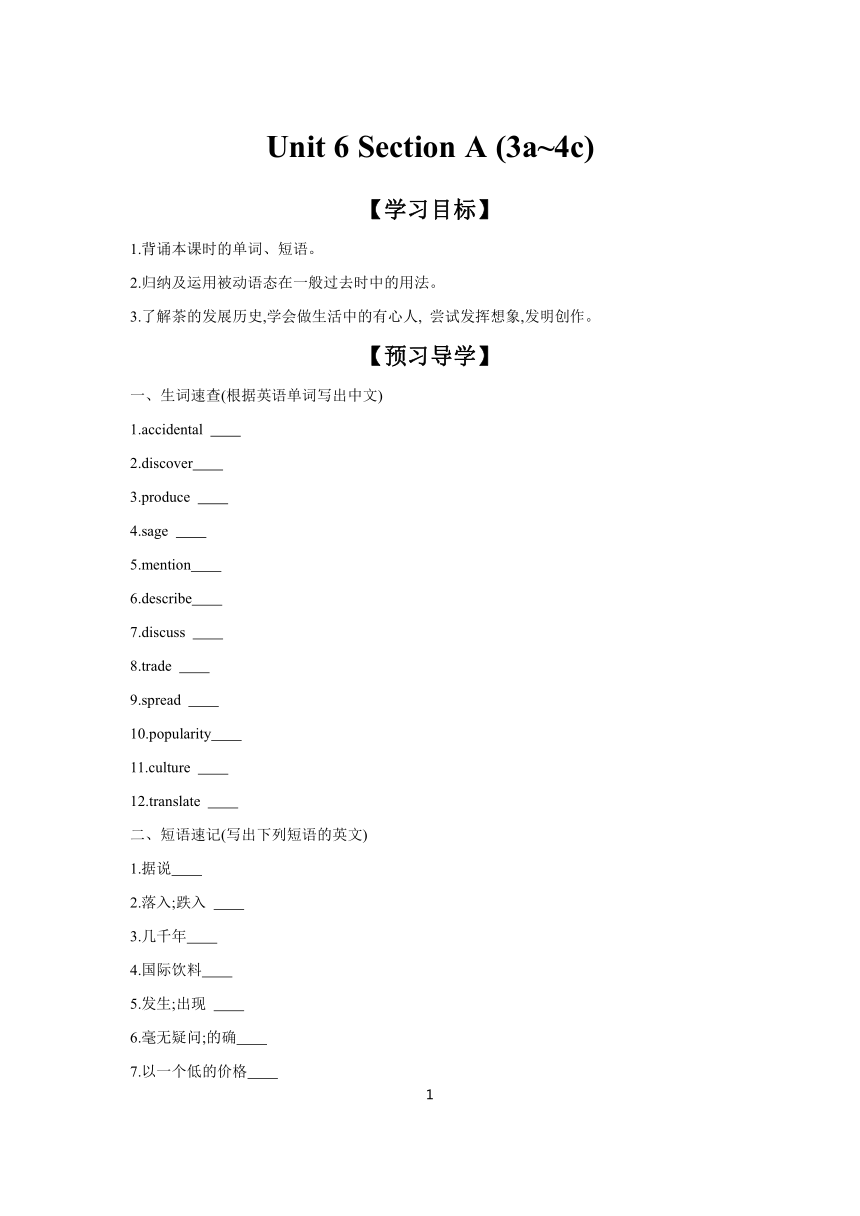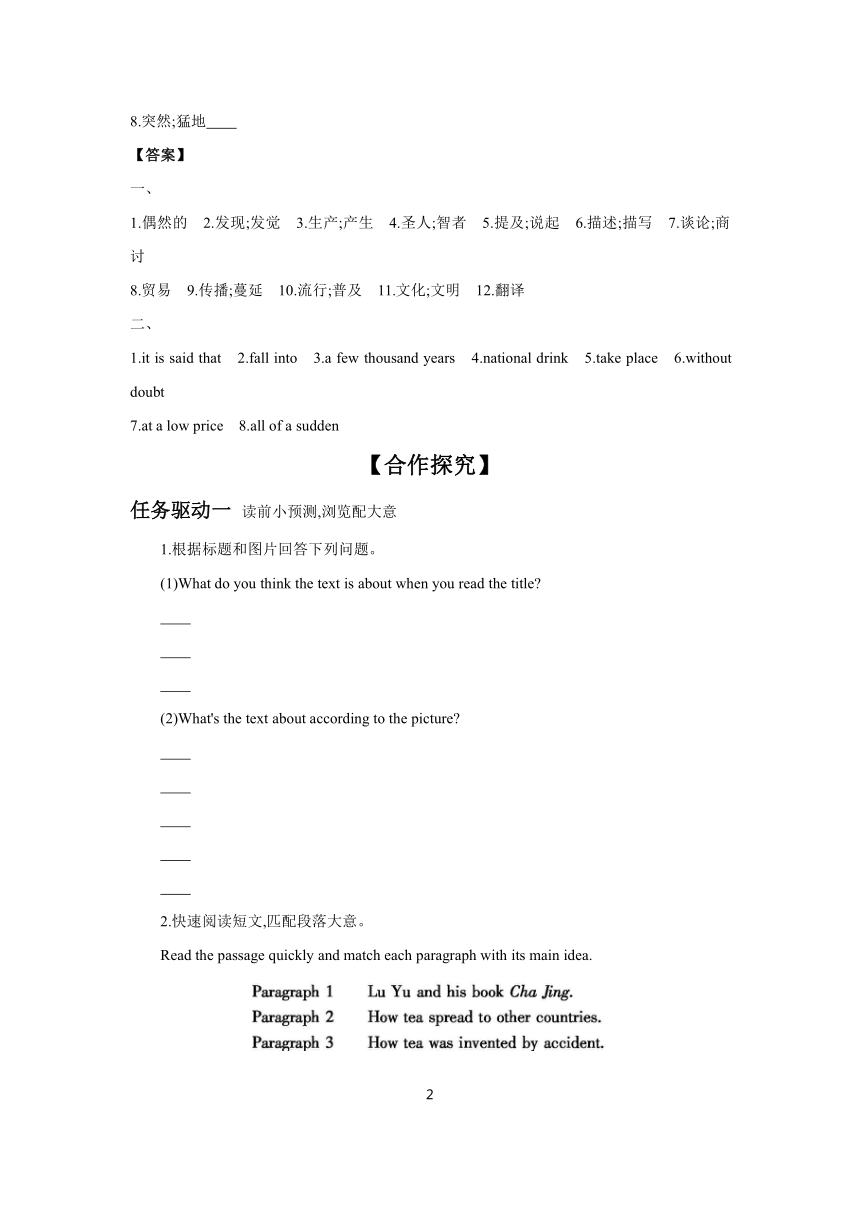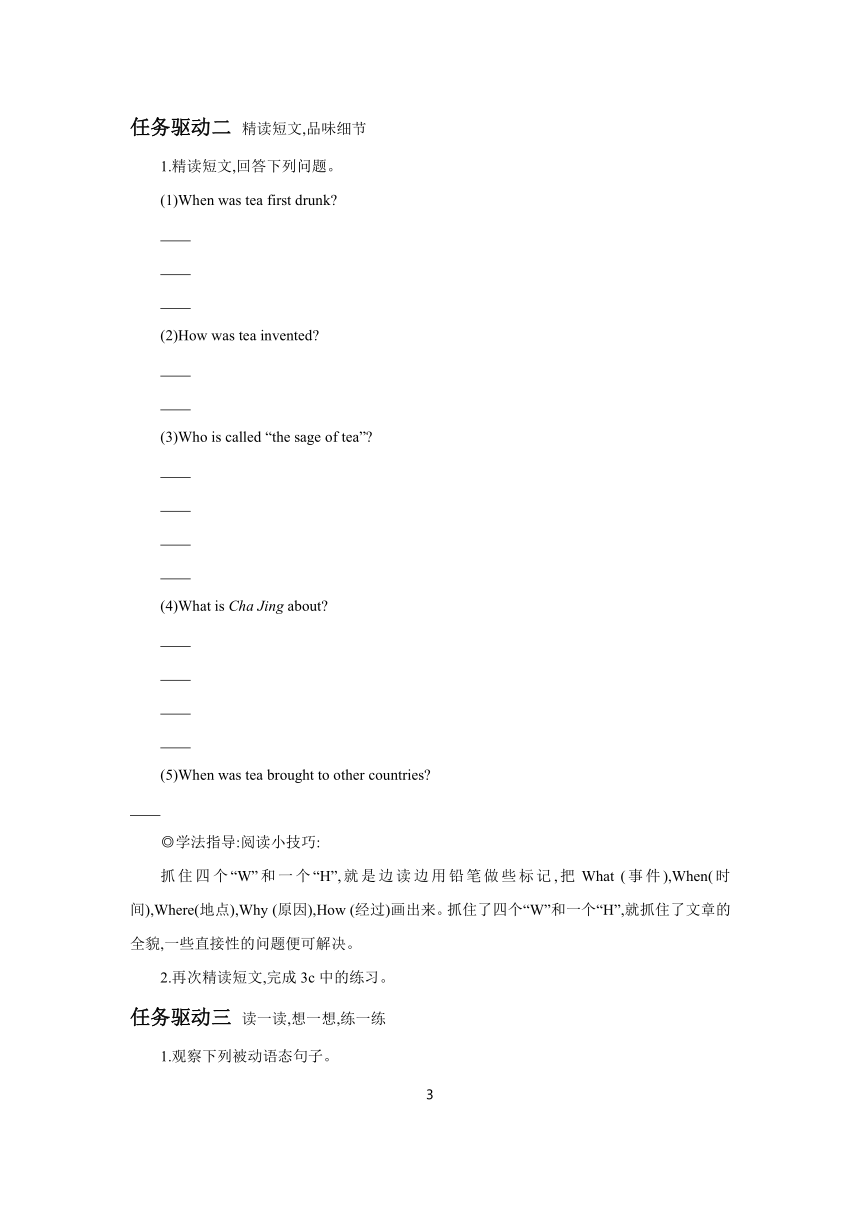Unit 6 When was it invented?Section A (3a~4c) 学案 人教版九年级全一册(含答案)
文档属性
| 名称 | Unit 6 When was it invented?Section A (3a~4c) 学案 人教版九年级全一册(含答案) |  | |
| 格式 | docx | ||
| 文件大小 | 65.6KB | ||
| 资源类型 | 教案 | ||
| 版本资源 | 人教新目标(Go for it)版 | ||
| 科目 | 英语 | ||
| 更新时间 | 2024-02-21 16:50:39 | ||
图片预览



文档简介
Unit 6 Section A (3a~4c)
【学习目标】
1.背诵本课时的单词、短语。
2.归纳及运用被动语态在一般过去时中的用法。
3.了解茶的发展历史,学会做生活中的有心人, 尝试发挥想象,发明创作。
【预习导学】
一、生词速查(根据英语单词写出中文)
1.accidental
2.discover
3.produce
4.sage
5.mention
6.describe
7.discuss
8.trade
9.spread
10.popularity
11.culture
12.translate
二、短语速记(写出下列短语的英文)
1.据说
2.落入;跌入
3.几千年
4.国际饮料
5.发生;出现
6.毫无疑问;的确
7.以一个低的价格
8.突然;猛地
【答案】
一、
1.偶然的 2.发现;发觉 3.生产;产生 4.圣人;智者 5.提及;说起 6.描述;描写 7.谈论;商讨
8.贸易 9.传播;蔓延 10.流行;普及 11.文化;文明 12.翻译
二、
1.it is said that 2.fall into 3.a few thousand years 4.national drink 5.take place 6.without doubt
7.at a low price 8.all of a sudden
【合作探究】
任务驱动一 读前小预测,浏览配大意
1.根据标题和图片回答下列问题。
(1)What do you think the text is about when you read the title
(2)What's the text about according to the picture
2.快速阅读短文,匹配段落大意。
Read the passage quickly and match each paragraph with its main idea.
任务驱动二 精读短文,品味细节
1.精读短文,回答下列问题。
(1)When was tea first drunk
(2)How was tea invented
(3)Who is called “the sage of tea”
(4)What is Cha Jing about
(5)When was tea brought to other countries
◎学法指导:阅读小技巧:
抓住四个“W”和一个“H”,就是边读边用铅笔做些标记,把What (事件),When(时间),Where(地点),Why (原因),How (经过)画出来。抓住了四个“W”和一个“H”,就抓住了文章的全貌,一些直接性的问题便可解决。
2.再次精读短文,完成3c中的练习。
任务驱动三 读一读,想一想,练一练
1.观察下列被动语态句子。
①Tea was invented by accident.②Tea wasn't brought to the western world. ③It's used for serving really cold ice-cream. 尽可能多地小组讨论,归纳总结主动语态变被动语态的语法规则,熟记运用口诀:宾变主, 主变宾, 谓变be done,时不变,数、格必须随着变。
2.完成4a。Rewrite the sentences using the passive voice.
3.完成4b。Complete the sentences with the correct forms of the verbs in the box.
4.完成4c。Decide whether active or passive forms should be used in these sentences. Write the correct forms in the blanks.
◎学法指导:学习体会被动语态的使用。被动语态是由“助动词be或动词get+过去分词”构成的,过去分词保持不变,而所有的变化,即人称、数、时态的变化,都体现在助动词be或动词get的变化上。
【答案】
任务驱动一
1.(1)An invention that was invented by accident.
(2)Tea. / The invention of tea.
2.
任务驱动二
(1)It was first drunk about 5,000 years ago.
(2)Some leaves from a tea plant fell into the boiling water. It produced a nice smell and tasted delicious. This is how tea was invented.
(3)Lu Yu is called “ the sage of tea”.
(4)It describes how tea plants were grown and used to make tea.
(5)It was brought to Korea and Japan during the 6th and 7th centuries and to England around 1660.
【知识超市】
[命题点一]
The emperor noticed that the leaves in the water produced a pleasant smell.这位皇帝注意到水中的叶子发出一种怡人的气味。
◎观察思考:
1.It is pleasant for me to see you.看到你我真高兴。
2.The chemistry teacher is pleased with my grades.化学老师对我的成绩很满意。
◎用法总结:pleasant是形容词,意为“令人愉快的;舒畅的;非常好的;讨人喜欢的”,形容事物本身的性质,一般用作定语,如果主语是物,也可以用作表语。
pleased是形容词,意为“高兴的;满足的”,在句中常用作表语,常构成短语:be pleased with sb.,意为“对某人满意”。
对点自测
完成句子
1.Our teacher our school work.我们的老师对我们的学业很满意。
2.I think chatting with my parents is a thing.我认为和父母聊天是一件令人愉快的事。
[命题点二]
In England, tea didn't appear until around 1660, but in less than 100 years, it had become the national drink. 直到1660年茶才被引入英国,但是不到100年后,茶就已经成为英国的国饮。
◎观察思考:
1.Let's wait until the rain stops.让我们等到雨停吧。
2.You can't go out until you've finished the work.你不把这项工作做完就不能出去。
◎用法总结:until 用在否定句中,表示句子的动作直到所表示的时间才开始发生,即表示动作的起点。一般译为“直到……才”或“直到……之前(……还不)” 。例如:
I won't leave until you promise to help me.直到你答应帮助我之前我都不会离开。
对点自测
完成句子
1.直到昨天晚上12点,他才上床睡觉。
He go to bed 12 o'clock last night.
2.直到你完成你的家庭作业,你才能和朋友们出去。
You go out with your friends you finish your homework.
【答案】
命题点一
对点自测
1.is pleased with 2.pleasant
命题点二
对点自测
1.didn't until 2.can't until
2
【学习目标】
1.背诵本课时的单词、短语。
2.归纳及运用被动语态在一般过去时中的用法。
3.了解茶的发展历史,学会做生活中的有心人, 尝试发挥想象,发明创作。
【预习导学】
一、生词速查(根据英语单词写出中文)
1.accidental
2.discover
3.produce
4.sage
5.mention
6.describe
7.discuss
8.trade
9.spread
10.popularity
11.culture
12.translate
二、短语速记(写出下列短语的英文)
1.据说
2.落入;跌入
3.几千年
4.国际饮料
5.发生;出现
6.毫无疑问;的确
7.以一个低的价格
8.突然;猛地
【答案】
一、
1.偶然的 2.发现;发觉 3.生产;产生 4.圣人;智者 5.提及;说起 6.描述;描写 7.谈论;商讨
8.贸易 9.传播;蔓延 10.流行;普及 11.文化;文明 12.翻译
二、
1.it is said that 2.fall into 3.a few thousand years 4.national drink 5.take place 6.without doubt
7.at a low price 8.all of a sudden
【合作探究】
任务驱动一 读前小预测,浏览配大意
1.根据标题和图片回答下列问题。
(1)What do you think the text is about when you read the title
(2)What's the text about according to the picture
2.快速阅读短文,匹配段落大意。
Read the passage quickly and match each paragraph with its main idea.
任务驱动二 精读短文,品味细节
1.精读短文,回答下列问题。
(1)When was tea first drunk
(2)How was tea invented
(3)Who is called “the sage of tea”
(4)What is Cha Jing about
(5)When was tea brought to other countries
◎学法指导:阅读小技巧:
抓住四个“W”和一个“H”,就是边读边用铅笔做些标记,把What (事件),When(时间),Where(地点),Why (原因),How (经过)画出来。抓住了四个“W”和一个“H”,就抓住了文章的全貌,一些直接性的问题便可解决。
2.再次精读短文,完成3c中的练习。
任务驱动三 读一读,想一想,练一练
1.观察下列被动语态句子。
①Tea was invented by accident.②Tea wasn't brought to the western world. ③It's used for serving really cold ice-cream. 尽可能多地小组讨论,归纳总结主动语态变被动语态的语法规则,熟记运用口诀:宾变主, 主变宾, 谓变be done,时不变,数、格必须随着变。
2.完成4a。Rewrite the sentences using the passive voice.
3.完成4b。Complete the sentences with the correct forms of the verbs in the box.
4.完成4c。Decide whether active or passive forms should be used in these sentences. Write the correct forms in the blanks.
◎学法指导:学习体会被动语态的使用。被动语态是由“助动词be或动词get+过去分词”构成的,过去分词保持不变,而所有的变化,即人称、数、时态的变化,都体现在助动词be或动词get的变化上。
【答案】
任务驱动一
1.(1)An invention that was invented by accident.
(2)Tea. / The invention of tea.
2.
任务驱动二
(1)It was first drunk about 5,000 years ago.
(2)Some leaves from a tea plant fell into the boiling water. It produced a nice smell and tasted delicious. This is how tea was invented.
(3)Lu Yu is called “ the sage of tea”.
(4)It describes how tea plants were grown and used to make tea.
(5)It was brought to Korea and Japan during the 6th and 7th centuries and to England around 1660.
【知识超市】
[命题点一]
The emperor noticed that the leaves in the water produced a pleasant smell.这位皇帝注意到水中的叶子发出一种怡人的气味。
◎观察思考:
1.It is pleasant for me to see you.看到你我真高兴。
2.The chemistry teacher is pleased with my grades.化学老师对我的成绩很满意。
◎用法总结:pleasant是形容词,意为“令人愉快的;舒畅的;非常好的;讨人喜欢的”,形容事物本身的性质,一般用作定语,如果主语是物,也可以用作表语。
pleased是形容词,意为“高兴的;满足的”,在句中常用作表语,常构成短语:be pleased with sb.,意为“对某人满意”。
对点自测
完成句子
1.Our teacher our school work.我们的老师对我们的学业很满意。
2.I think chatting with my parents is a thing.我认为和父母聊天是一件令人愉快的事。
[命题点二]
In England, tea didn't appear until around 1660, but in less than 100 years, it had become the national drink. 直到1660年茶才被引入英国,但是不到100年后,茶就已经成为英国的国饮。
◎观察思考:
1.Let's wait until the rain stops.让我们等到雨停吧。
2.You can't go out until you've finished the work.你不把这项工作做完就不能出去。
◎用法总结:until 用在否定句中,表示句子的动作直到所表示的时间才开始发生,即表示动作的起点。一般译为“直到……才”或“直到……之前(……还不)” 。例如:
I won't leave until you promise to help me.直到你答应帮助我之前我都不会离开。
对点自测
完成句子
1.直到昨天晚上12点,他才上床睡觉。
He go to bed 12 o'clock last night.
2.直到你完成你的家庭作业,你才能和朋友们出去。
You go out with your friends you finish your homework.
【答案】
命题点一
对点自测
1.is pleased with 2.pleasant
命题点二
对点自测
1.didn't until 2.can't until
2
同课章节目录
- Unit 1 How can we become good learners.
- Section A
- Section B
- Unit 2 I think that mooncakes are delicious!
- Section A
- Section B
- Unit 3 Could you please tell me where the restroom
- Section A
- Section B
- Unit 4 I used to be afraid of the dark.
- Section A
- Section B
- Unit 5 What are the shirts made of?
- Section A
- Section B
- Review of Units 1-5
- Unit 6 When was it invented?
- Section A
- Section B
- Unit 7 Teenagers should be allowed to choose their
- Section A
- Section B
- Unit 8 It must belong to Carla.
- Section A
- Section B
- Unit 9 I like music that I can dance to.
- Section A
- Section B
- Unit 10 You're supposed to shake hands.
- Section A
- Section B
- Review of Units 6-10
- Unit 11 Sad movies make me cry.
- Section A
- Section B
- Unit 12 Life is full of the unexpected
- Section A
- Section B
- Unit 13 We're trying to save the earth!
- Section A
- Section B
- Unit 14 I remember meeting all of you in Grade 7.
- Section A
- Section B
- Review of Units 11-14
